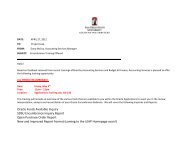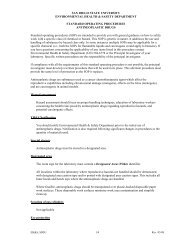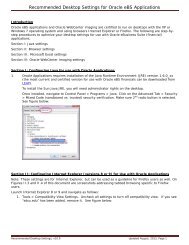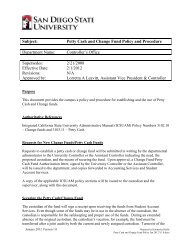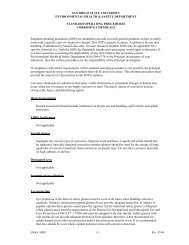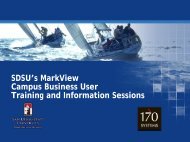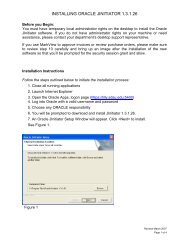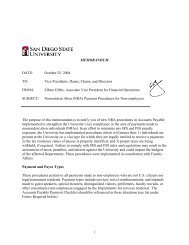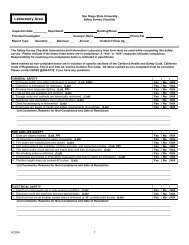Principles and Practices of Biosafety - San Diego State University
Principles and Practices of Biosafety - San Diego State University
Principles and Practices of Biosafety - San Diego State University
Create successful ePaper yourself
Turn your PDF publications into a flip-book with our unique Google optimized e-Paper software.
<strong>Principles</strong> <strong>and</strong> <strong>Practices</strong> <strong>of</strong><br />
<strong>Biosafety</strong><br />
Environmental Health <strong>and</strong> Safety<br />
<strong>San</strong> <strong>Diego</strong> <strong>State</strong> <strong>University</strong>
Abbreviations<br />
• BSC – <strong>Biosafety</strong> Cabinet<br />
• BSL – <strong>Biosafety</strong> Level<br />
• ABSL – Animal <strong>Biosafety</strong> B<br />
Level<br />
• BSO – <strong>Biosafety</strong> Officer<br />
• BUA – Biological Use Authorization<br />
• CA – California<br />
• CDC – Center for Disease Control <strong>and</strong><br />
Prevention<br />
• DGR – Dangerous Goods Regulations<br />
• DOT – Department <strong>of</strong> Transportation<br />
• EHS – Environmental Health <strong>and</strong><br />
Safety<br />
• EPA – Environmental Protection<br />
Agency<br />
• HMR – Hazardous Materials<br />
Regulations<br />
• IACUC – Institutional Animal Care<br />
<strong>and</strong> Use Committee<br />
• IATA – International Air Transport<br />
Association<br />
• IBC – Institutional <strong>Biosafety</strong><br />
Committee<br />
• IRB – Institutional Review Board<br />
• NIH – National Institute <strong>of</strong> Health<br />
• OSHA – Occupational Health <strong>and</strong><br />
Safety Administration<br />
• PI – Principal Investigator<br />
• PP – Physical Plant<br />
• PPE – Personal Protective Equipment<br />
• PS – Pubic Safety<br />
• SD – <strong>San</strong> <strong>Diego</strong><br />
• USPS – U.S. Postal Service
Introduction<br />
The management <strong>of</strong> biological hazards through the<br />
proper application <strong>of</strong> engineered containment <strong>and</strong><br />
administrative controls is referred to as biosafety<br />
or biohazard control.<br />
<strong>Biosafety</strong> or biohazard control is a team effort<br />
involving the PI, research lab personnel, BSO,<br />
IBC, IRB, IACUC, EHS, PP <strong>and</strong> PS.
Regulatory Requirements <strong>and</strong><br />
Guidelines<br />
• NIH Guidelines for Research Involving<br />
Recombinant DNA Molecules (April 2002)<br />
• CDC/NIH <strong>Biosafety</strong> in Microbiological <strong>and</strong><br />
Biomedical Laboratories (May 1999)<br />
• CAL/OSHA Bloodborne Pathogen St<strong>and</strong>ard<br />
• CA Medical Waste Management Act<br />
• DOT Transportation <strong>of</strong> Hazardous<br />
Materials
SDSU <strong>Biosafety</strong> Requirements<br />
<strong>and</strong> Guidelines<br />
• Policies established by the Institutional <strong>Biosafety</strong><br />
Committee (IBC) that meet or exceed applicable<br />
guidelines <strong>and</strong> regulations for use <strong>of</strong> RG 2 <strong>and</strong><br />
RG 3 biohazardous materials or agents as well as<br />
non-exempt NIH Recombinant DNA research.<br />
• Policies established by Environmental Health <strong>and</strong><br />
Safety (EHS) that meet or exceed applicable<br />
regulations <strong>and</strong> guidelines for minimizing<br />
bloodborne pathogen exposure <strong>and</strong> disposal <strong>of</strong><br />
biohazardous wastes.
Biohazardous Material<br />
• Infectious microorganisms<br />
(bacteria, viruses, fungi,<br />
parasites, prions,<br />
rickettsiae, etc.) affecting<br />
humans <strong>and</strong> animals<br />
• Diagnostic (clinical)<br />
specimens<br />
• Recombinant DNA (viral<br />
vectors, gene therapy,<br />
cloning)<br />
• Genetically Modified<br />
Microorganisms<br />
(transgenic plants <strong>and</strong><br />
animals)<br />
• Human <strong>and</strong> non-human<br />
primate cells, cell culture<br />
(primary <strong>and</strong><br />
immortalized), tissues,<br />
blood (whole blood or any<br />
components) <strong>and</strong> body<br />
fluids<br />
• Animal or plant cells, cell<br />
cultures, fluids, tissues or<br />
derived wastes which<br />
may contain pathogens<br />
• Animals known to be<br />
reservoirs <strong>of</strong> zoonotic<br />
disease
Institutional <strong>Biosafety</strong> Committee<br />
<strong>and</strong><br />
Biological Use Authorization
Biological Use Authorization<br />
(BUA) Application<br />
• BSL 1, ABSL 1 <strong>and</strong> NIH-Exempt<br />
Reviewed <strong>and</strong> approved by BSO<br />
• BSL 2 or 3, ABSL 2 or 3 <strong>and</strong> NIH- Non-exempt<br />
Reviewed <strong>and</strong> approved by IBC<br />
Currently, no facilities at SDSU meet the<br />
minimum criteria for BSL 4; thus this type <strong>of</strong><br />
work is prohibited.
Submission <strong>of</strong> New BUA<br />
• New infectious agents<br />
• New cell lines<br />
• New vector system<br />
• Enhanced replication or infectivity<br />
• Expression <strong>of</strong> toxic products<br />
• Partial genomes increased to more than two-thirds<br />
thirds<br />
<strong>of</strong> whole genome<br />
• New or altered procedures that pose increased risk<br />
(e.g., aerosol or other type <strong>of</strong> exposure)<br />
• Work with non-human systems being changed<br />
into work with human system
SDSU <strong>Biosafety</strong> Approval<br />
Institutional <strong>Biosafety</strong> Committee (IBC)<br />
Protocol Review<br />
Biological Use Authorization (BUA) with<br />
respect to containment level (biosafety<br />
level)<br />
Training<br />
Inspection
Principal Investigator<br />
• Develops specific protocols to ensure the safe use<br />
<strong>of</strong> biohazardous materials.<br />
• Submits a BUA application <strong>and</strong> obtains approval<br />
from IBC prior to commencement <strong>of</strong> work.<br />
• Complies with specific biosafety protocols,<br />
practices <strong>and</strong> procedures described in the<br />
biohazard control manual.<br />
• Ensures that all laboratory staff are appropriately<br />
trained on biosafety.<br />
• Reports any significant problems, violations <strong>of</strong><br />
the policies, practices <strong>and</strong> procedures, or any<br />
significant research-related related accidents <strong>and</strong>/or<br />
laboratory acquired infection to the BSO<br />
immediately.
Laboratory Staff<br />
• Comply with the specific biosafety<br />
protocols, practices <strong>and</strong> procedures<br />
described in the biohazard control manual.<br />
• Report to the PI or the lab manager all<br />
problems, spills or violations in procedure<br />
immediately.
Risk Group<br />
<strong>and</strong><br />
<strong>Biosafety</strong> Level
Classification <strong>of</strong> Infective Agents<br />
by Risk Group<br />
• Pathogenicity<br />
• Infectious Dose<br />
• Mode <strong>of</strong> Transmission<br />
• Host Range<br />
• Availability <strong>of</strong> Effective Preventive<br />
Measures <strong>and</strong> Treatment
Classification <strong>of</strong> Infective Agents<br />
by Risk Group<br />
Risk Group 1 Risk Group 2 Risk Group 3 Risk Group 4<br />
Severity <strong>of</strong><br />
Disease<br />
unlikely to<br />
cause human<br />
or animal<br />
disease<br />
can cause disease,<br />
unlikely to be<br />
serious, effective<br />
treatment <strong>and</strong><br />
preventive measures<br />
available<br />
can cause serious<br />
disease, does not<br />
ordinarily spread<br />
from one person to<br />
another, effective<br />
treatment <strong>and</strong><br />
preventive measures<br />
usually available,<br />
exposure route:<br />
inhalation (<strong>of</strong>ten)<br />
likely to cause serious or<br />
lethal disease, can be<br />
readily transmitted from<br />
one individual to another,<br />
effective treatment <strong>and</strong><br />
preventive measures are<br />
not usually available,<br />
transmission: direct,<br />
indirect, inhalation<br />
Host Range<br />
human<br />
(healthy adult)<br />
<strong>and</strong> animals<br />
human (healthy<br />
adult) <strong>and</strong> animals<br />
human (healthy<br />
adult) <strong>and</strong> animals<br />
human (healthy adult) <strong>and</strong><br />
animals<br />
Individual<br />
Risk<br />
low<br />
moderate (potential<br />
hazard)<br />
high<br />
high<br />
Community<br />
Risk<br />
low low low high
Classification <strong>of</strong> Containment by<br />
<strong>Biosafety</strong> Levels<br />
• <strong>Practices</strong> <strong>and</strong> Procedures<br />
• Containment Equipment (Primary Barriers)<br />
• Containment Facility (Secondary Barriers)<br />
Note: CDC/NIH has 4 biosafety level classifications<br />
currently in use. Each level is appropriate for:<br />
Operations Performed<br />
Routes <strong>of</strong> Transmission (ingestion, inoculation,<br />
inhalation, mucous membrane exposure)<br />
Laboratory Function
Risk Group <strong>and</strong> <strong>Biosafety</strong> Level<br />
Classifications<br />
• Not appropriate to use risk group or<br />
biosafety level when assessing toxins.<br />
• Can be found in the American Biological<br />
Safety Association website:<br />
www.absa.org/resriskgroup<br />
• Risk Groups <strong>and</strong> <strong>Biosafety</strong> Levels are not<br />
always the same!
Bloodborne Pathogen<br />
St<strong>and</strong>ard
Introduction<br />
• California Code <strong>of</strong> Regulations, Title 8, Sec 5193<br />
• Applies to all employees who could “reasonably<br />
anticipate” as a result <strong>of</strong> performing their job tasks<br />
contact with blood <strong>and</strong> other potentially infectious<br />
material (OPIM) i.e., body fluids, unfixed tissues<br />
or organs<br />
• Limit occupational exposure to blood <strong>and</strong> OPIM<br />
which could result in transmission <strong>of</strong> bloodborne<br />
pathogens i.e., Hepatitis B virus (HBV), HIV<br />
• Requires a written Exposure Control Plan
Elements <strong>of</strong> an Exposure Control<br />
Plan<br />
• Exposure Determination<br />
• Method <strong>of</strong> Compliance<br />
• HIV, HBV <strong>and</strong> HCV Research Laboratories<br />
• Hepatitis B Vaccination <strong>and</strong> Post-Exposure<br />
Evaluation <strong>and</strong> Follow-Up<br />
• Hazard Communication<br />
• Record Keeping<br />
• Evaluation <strong>of</strong> Exposure Incidents<br />
• Sharps Injury Log
Exposure Determination<br />
• Exposure evaluation based upon the job<br />
description.<br />
• Exposure evaluation based upon reasonably<br />
anticipated contact (skin, eye, mucous<br />
membrane, parenteral contact, etc.) with<br />
blood or other potentially infectious<br />
materials resulting from performing the<br />
assigned tasks.
Method <strong>of</strong> Compliance<br />
• Universal Precaution – treating all human blood <strong>and</strong><br />
certain human body fluids as if infectious for bloodborne<br />
pathogens<br />
• Engineering <strong>and</strong> Work Practice Controls<br />
<br />
<br />
<br />
<br />
<br />
Needleless system or needles/sharps with engineered sharps injury<br />
protection<br />
Needles <strong>and</strong> other sharps shall not be recapped, bent or broken<br />
Needles <strong>and</strong> other sharps shall be disposed in rigid, puncture-<br />
pro<strong>of</strong>, leak resistant <strong>and</strong> properly labeled sharps container<br />
Sharps container shall be closed immediately prior to removal or<br />
replacement to prevent spillage or protrusion <strong>of</strong> contents during<br />
h<strong>and</strong>ling or transport<br />
Specimens <strong>of</strong> blood or OPIM shall be placed in a closable,<br />
leakpro<strong>of</strong>, properly labeled red bag prior to h<strong>and</strong>ling, collection n or<br />
transport<br />
• Personal Protective Clothing <strong>and</strong> Equipment
Hepatitis B Vaccination <strong>and</strong><br />
Post-Exposure Follow-Ups<br />
• Hepatitis B vaccination shall be provided at<br />
no cost to employee who has a potential for<br />
becoming exposed to blood or OPIM.<br />
• Post-exposure follow-ups shall be provided<br />
if an occupational exposure occurs.
Hazard Communication<br />
1. Signs <strong>and</strong> Labels<br />
• Signs shall be posted at the entrance to the work areas<br />
which shall bear:<br />
Name <strong>of</strong> infectious agent<br />
International symbol for biohazard in fluorescent<br />
orange-red<br />
red<br />
Special requirements for entering the area<br />
Name <strong>and</strong> telephone number <strong>of</strong> lab director or other<br />
responsible person<br />
Warning labels shall be affixed to containers <strong>of</strong><br />
infectious wastes, refrigerators <strong>and</strong> freezers<br />
containing blood or OPIM, or other containers used<br />
to store or transport blood or OPIM.<br />
• Labels shall have the international symbol for biohazard<br />
in fluorescent orange-red<br />
red<br />
2. Training
Pathogenic Microbiology
Bacterial Laboratory Acquired<br />
Infections<br />
• 76% <strong>of</strong> exposures occurred in clinical labs;<br />
6% in vaccine manufacturing facilities; 8%<br />
in research labs.<br />
• Exposure modes: 60% inhalation, other<br />
exposure modes included ingestion<br />
(intentional, poor technique such as mouth<br />
pipetting, smoking <strong>and</strong> eating in the lab)<br />
<strong>and</strong> secondary transmission.
Viral Laboratory Acquired<br />
Infections<br />
• >70% associated with research labs; 32% <strong>of</strong> all<br />
viral LAIs associated with animals<br />
• 18% <strong>of</strong> total were Hantavirus; <strong>of</strong> these, 8% were<br />
working with known infectious material or rodents<br />
- others thought they were working with<br />
uninfected rodents<br />
• 16% were in clinical labs; rest were in production<br />
or field work<br />
• Major exposure modes: inhalation, percutaneous<br />
(especially from animals)
Rickettsial Laboratory Acquired<br />
Infections<br />
• All rickettsial LAIs were associated with research<br />
laboratories<br />
• 95% <strong>of</strong> overt infections were by Coxiella burnetii;<br />
remainder were Murine typhus<br />
• All Q fever cases by inhalation; all infected staff<br />
worked with or were in close proximity to sheep<br />
• Remaining cases were by percutaneous,<br />
inhalation, mucous membrane or unknown<br />
exposure modes
Molecular Biology
It’s a Matter <strong>of</strong> Perspective<br />
• The investigators who submit IBC protocols<br />
want to perform their experiments safely.<br />
• However, their perception <strong>of</strong> the risks<br />
involved will not necessarily be the same as<br />
that <strong>of</strong> a biosafety pr<strong>of</strong>essional.
Risk Assessment<br />
The following risk assessment will identify the<br />
biological containment system to be used:<br />
Properties <strong>of</strong> the donor organism<br />
Nature <strong>of</strong> the DNA sequences that will be<br />
transferred<br />
Properties <strong>of</strong> the recipient organism<br />
Properties <strong>of</strong> the environment
Biological Expression System<br />
Most routine genetic engineering experiments<br />
can be performed safely in E. coli<br />
K12/pUC18 at BSL 1 provided the inserted<br />
foreign DNA sequences do not require a<br />
higher BSL.
Donor Organism <strong>and</strong> Cloned DNA<br />
Insertion <strong>of</strong> well-characterized DNA sequences that<br />
are unlikely to be involved in pathogenicity may<br />
not require additional safety measures.<br />
In cases where these sequences are not characterized,<br />
a situation that is typically encountered when a<br />
library <strong>of</strong> genomic DNA <strong>of</strong> an organism is being<br />
established, a higher BSL will be required.<br />
Cloning <strong>of</strong> genes coding for proteins that have<br />
potential pharmacological activity such as toxins<br />
may therefore require higher BSL.
Viral Vectors for Gene Transfer<br />
Although viral vectors used in gene therapy or<br />
gene transfer are replication-defective, they<br />
should be h<strong>and</strong>led at the same BSL as the<br />
parent viral vector from which they are<br />
derived since the virus stocks may be<br />
contaminated with replication-competent<br />
competent<br />
viruses, which are generated by rare<br />
spontaneous recombination events in the<br />
complementing cell line.
Transgenic <strong>and</strong> “Knock-Out”<br />
Animals<br />
Animals carrying foreign genetic information<br />
(transgenic animals) should be h<strong>and</strong>led in the<br />
containment level appropriate to the characteristics<br />
<strong>of</strong> the products <strong>of</strong> the foreign genes. For each new<br />
line <strong>of</strong> transgenic animal, the routes by which the<br />
animals can be infected, the inoculum size<br />
required for infection, <strong>and</strong> the extent <strong>of</strong> the virus<br />
shedding by the infected animal must be<br />
determined.<br />
Animals with targeted deletions <strong>of</strong> specific genes<br />
(“knock-out” animals) do not generally present<br />
particular biological hazards.
Human <strong>and</strong> Other Primate<br />
Cells <strong>and</strong> Tissues
Human Source Material<br />
• Blood <strong>and</strong> blood products<br />
• Vaginal secretions<br />
• Semen<br />
• Amniotic fluid<br />
• Unfixed tissues<br />
• Cerebrospinal, synovial,<br />
pleural, pericardial <strong>and</strong><br />
peritoneal fluids<br />
• Cell cultures<br />
• Saliva<br />
• Urine<br />
• Tears<br />
• Sputum<br />
• Feces<br />
• Vomit<br />
• Other excretions <strong>and</strong><br />
secretions<br />
Second column not covered in Bloodborne Pathogen St<strong>and</strong>ard, possibly not<br />
occupationally related.
Human Source Material<br />
• May transmit infectious agents<br />
• Imperfect knowledge <strong>of</strong> infectious status<br />
Incubation period (asymptomatic)<br />
No test for every pathogen<br />
• Most tissues <strong>and</strong> body fluids<br />
Bloodborne Pathogens (HBV, HCV, HIV,<br />
HTLV-1)<br />
Pathogens causing Malaria, Syphilis,<br />
Babesiosis, Brucellosis, Leptospirosis,<br />
Arboviral infections, Relapsing fever,<br />
Creutzfeldt-Jacob disease <strong>and</strong> viral<br />
hemorrhagic fever
Cell Culture Risks<br />
• Contaminating pathogenic agents<br />
natural (<strong>of</strong>ten zoonotic) or inadvertent<br />
~20 LAIs from primary cultures in last 30 years<br />
e.g., Herpes B (CHV-1), prions<br />
• Oncogenic potential<br />
could be oncogene or oncogenic agent<br />
e.g., HPV-18, MPMV genomes in HeLa cells<br />
• Unexpected (adventitious) agents<br />
e.g., SIV, STLV, SV5 in primate cells, HHV-8<br />
in BCBL-1 1 cells<br />
• Hazardous chemicals added to culture medium
Cell Culture under Bloodborne<br />
Pathogen St<strong>and</strong>ard<br />
• ABSA requested OSHA’s s interpretation in 1994:<br />
Do human cell cultures fall under the<br />
Bloodborne Pathogen (BBP) St<strong>and</strong>ard<br />
• Response:<br />
All primary human cell cultures (explants) <strong>and</strong><br />
subsequent in vitro passages fall under the<br />
BBP St<strong>and</strong>ard<br />
To be exempted from the BBP requirements,<br />
cell strains <strong>and</strong> lines must undergo testing <strong>and</strong><br />
characterization (documented) for bloodborne<br />
pathogens (not just HBV, HCV <strong>and</strong> HIV)
Cell Culture Safety<br />
• Extend Universal/St<strong>and</strong>ard Precautions to all<br />
human <strong>and</strong> animal cell cultures<br />
Consider working at BSL 2 (most work<br />
there already to protect the cell cultures)<br />
H<strong>and</strong>le all cultures in a biosafety cabinet<br />
If human origin <strong>and</strong> not demonstrated to<br />
be free <strong>of</strong> human bloodborne pathogens,<br />
adhere to requirements <strong>of</strong> the BBP St<strong>and</strong>ard<br />
Wear PPE appropriate to human source<br />
material
Summary<br />
Human Source Materials<br />
• May be regulated<br />
• Can be biohazardous<br />
• Use Universal Precautions at<br />
all times<br />
• Visible blood means<br />
increased risk<br />
• Don’t t consider “normal”<br />
source<br />
Human <strong>and</strong> Non-<br />
human Primate Cell<br />
Cultures<br />
• Treat human cultures as<br />
possible biohazards<br />
• Beware <strong>of</strong> non-human<br />
primate cells<br />
• Beware <strong>of</strong> CNS, corneal,<br />
pituitary cells<br />
• Some cells may be OK at<br />
BSL 1
Animals <strong>and</strong> Allergens
Risk Assessment for Work with<br />
Research Animals<br />
• Risks associated with the research agent used in<br />
the animal<br />
chemical, physical, biological<br />
• Risks associated with the species <strong>of</strong> animal used<br />
zoonotic agents<br />
• Risks associated with animal maintenance<br />
ergonomic factors, bites, scratches, allergens
Risks Associated with the Agent<br />
Used<br />
• Chemical agents<br />
carcinogens, mutagens<br />
toxic chemicals<br />
anesthetics<br />
• Physical agents<br />
radiation<br />
heat<br />
sound
Risks Associated with the Agent<br />
Used<br />
• Potentially biohazardous agents<br />
deliberate use <strong>of</strong> an infectious agent in<br />
animals for research purposes<br />
maintenance <strong>of</strong> infected animal for<br />
duration <strong>of</strong> experiment<br />
sacrifice, necropsy <strong>and</strong> harvesting <strong>of</strong><br />
agent or infected tissue
Transmission <strong>of</strong> Biohazards<br />
During Work with Animals<br />
Airborne<br />
• Release <strong>of</strong> infectious aerosols by animal by<br />
sneezing, coughing<br />
• Release during nasal infection or aerosol<br />
challenge<br />
• Aerosolization from bedding <strong>and</strong> excreta<br />
• During surgical procedures<br />
• During birthing
Transmission <strong>of</strong> Biohazards<br />
During Work with Animals<br />
Direct Inoculation<br />
• Needlesticks during injection/inoculation<br />
process<br />
• Bites <strong>and</strong> scratches from infected animal
Transmission <strong>of</strong> Biohazards<br />
During Work with Animals<br />
Direct exposure <strong>of</strong> mucous membranes<br />
(by splash or splatter)<br />
• During surgical procedures<br />
• During injection<br />
• During necropsy
Transmission <strong>of</strong> Biohazards<br />
During Work with Animals<br />
Indirect transmission <strong>and</strong> ingestion<br />
• From contaminated h<strong>and</strong>s or gloves to mouth<br />
• Facial contamination directly from animal<br />
• Transfer <strong>of</strong> parasites by animal h<strong>and</strong>ling<br />
Indirect transmission with eye or mucous<br />
membrane exposure<br />
• Dust from bedding<br />
• Splash during cage washing<br />
• “Dirty” environment
Risk Reduction: Containment <strong>of</strong><br />
Infectious Agent<br />
• Containment must include:<br />
Primary containment<br />
Enclosed filtered caging system<br />
<strong>Biosafety</strong> cabinets<br />
Safety equipment<br />
PPE<br />
Secondary containment<br />
The containment facility<br />
• Negative pressurization<br />
• Nonrecirculated air supply<br />
• Ventilation must consider wellbeing <strong>of</strong> animal
Containment Caging Systems<br />
• No Containment<br />
Open (st<strong>and</strong>ard) cage<br />
• Some Containment<br />
Filter top cage<br />
(microisolator cage)<br />
• Full Containment<br />
Fully enclosed in<br />
ventilated rack
Containment Caging Systems<br />
• Microisolator Cage<br />
works like a Petri dish<br />
open gaps around lid edge allow limited air<br />
exchange<br />
may lead to more labor intensive husb<strong>and</strong>ry due<br />
to moisture <strong>and</strong> ammonia buildup
Containment Caging Systems<br />
• Individual cages sealed into rack with<br />
supplied air under negative pressure<br />
• Both supply <strong>and</strong> exhaust usually HEPA<br />
filtered<br />
• Ventilation must control humidity <strong>and</strong><br />
buildup <strong>of</strong> ammonia
Containment Caging Systems<br />
• Can install cages in class III biosafety<br />
cabinet<br />
• Cages are completely contained with glove<br />
port access<br />
• Very motion-limiting<br />
• Transfer in <strong>and</strong> out may be an issue
Containment Caging Systems<br />
• BioBubble (Ft. Collins, CO) makes s<strong>of</strong>t-<br />
wall ventilated enclosures<br />
• Can be containment or barrier style<br />
• Large equipment can be surface-mounted in<br />
wall
Special Animal Housing Situations<br />
• Barrier colonies<br />
Special breeds - <strong>of</strong>ten immunocompromised,<br />
“fragile”,, expensive (SCID-Hu, nude athymics)<br />
Transgenics - <strong>of</strong>ten even more fragile <strong>and</strong><br />
expensive (knockouts, microinjected, combos)<br />
Specific pathogen-free (SPF) - bred <strong>and</strong> raised<br />
to be missing certain specific microorganisms<br />
• Isolation colonies<br />
Extensive SPFs <strong>and</strong> defined flora animals<br />
Gnotobiotes (an entirely different animal!)
Zoonoses<br />
• Zoonotic disease: : A disease <strong>of</strong> animals that<br />
can be transmitted under natural conditions<br />
<strong>and</strong> cause disease in humans<br />
Wild caught animals most hazardous<br />
R<strong>and</strong>om source animals (e.g., from a<br />
pound) are also a risk<br />
Purpose bred animals pose least risk
Some Animals <strong>and</strong> Their<br />
Zoonoses<br />
• Animal<br />
Macaque monkeys<br />
Sheep<br />
White mouse<br />
Dogs, cats, skunks,<br />
raccoons, bats<br />
Cattle, NHP<br />
Cats<br />
Parrots, macaws<br />
Chickens<br />
• Disease<br />
Herpes B virus<br />
Q fever<br />
Hantavirus<br />
Rabies<br />
Tuberculosis<br />
Toxoplasmosis<br />
Psittacosis<br />
Avian influenza
Rodent Zoonoses<br />
• Rat bite fever (Streptobacillus(<br />
moniliformis,<br />
Spirillum minus)<br />
transmission: direct contact (bites)<br />
• Lymphocytic choriomeningitis (LCM, a virus)<br />
transmission: inhalation<br />
• Leptospirosis (Leptospira(<br />
spp.)<br />
transmission: inhalation<br />
• Others include ringworm (fungal), scabies (mites,<br />
an ectoparasite)
Transmission <strong>of</strong> Zoonoses<br />
• Enteric route (fecal/oral)<br />
Salmonella, Shigella, Campylobacter,<br />
Giardia, Toxoplasma, Cryptosporidium,<br />
Entamoeba, , Hepatitis A<br />
• Respiratory route<br />
Q fever, Chlamydia, , Measles<br />
• Skin contact<br />
Ringworm (Tinea), Measles, Monkeypox
Control <strong>of</strong> Zoonoses<br />
• Get information on<br />
species <strong>and</strong> agent<br />
• Quarantine animals prior<br />
to use<br />
• Use Engineering controls<br />
<br />
facility construction <strong>and</strong><br />
secondary barriers<br />
• Consider the need for<br />
containment caging<br />
• Use Administrative<br />
controls<br />
<br />
• Use PPE<br />
<br />
written SOPs <strong>and</strong><br />
manuals<br />
additional protection for<br />
worker<br />
• Practice good facility <strong>and</strong><br />
personal hygiene<br />
• Provide staff training
Laboratory Acquired Allergies<br />
(LAA)<br />
• Significant occupational disease<br />
• Affects >30% <strong>of</strong> all personnel working with<br />
animals<br />
• No minimum safe exposure levels to allergens<br />
have been established<br />
• Animal allergens found in hair, d<strong>and</strong>er, urine,<br />
saliva, serum<br />
fel-d-l l cat allergen (in saliva <strong>and</strong> thus on skin)<br />
is one <strong>of</strong> the strongest allergens known for<br />
humans
Sources <strong>of</strong> Exposure to LAA<br />
• Hair <strong>and</strong> d<strong>and</strong>er shed<br />
from animal<br />
• Urine <strong>and</strong> feces dried<br />
in bedding<br />
• Particulates shed from<br />
bedding material<br />
• Animal saliva
Routes <strong>of</strong> Exposure to LAA<br />
• Inhalation <strong>of</strong> airborne allergens<br />
during cage changing<br />
during animal h<strong>and</strong>ling<br />
• Skin or eye contact<br />
usually indirect by touching skin, eyes<br />
• Percutaneous exposure<br />
animal bites (saliva)
Risk Factors for Development <strong>of</strong><br />
LAA<br />
• Exposure to allergens<br />
duration<br />
frequency<br />
intensity<br />
• Previous allergic conditions<br />
• Other predisposing conditions<br />
illness<br />
Immunocompromised<br />
pets
LAA: Exposure Control<br />
• Engineering Controls<br />
enclosure<br />
dilution ventilation<br />
• Administrative Controls<br />
reduce time with animals<br />
reduce density <strong>of</strong> animals<br />
housekeeping practices<br />
• Personal Protective Equipment<br />
respirators <strong>and</strong> clothing<br />
• Medical Surveillance
Disinfection
Why Disinfect<br />
• To reduce or eliminate exposure risk<br />
Biohazard waste disposal<br />
Spill cleanup<br />
Routine surface decontamination<br />
• To eliminate contamination risk<br />
Preparation <strong>of</strong> microbiological media <strong>and</strong><br />
supplies<br />
Preparation <strong>of</strong> work area for cleanliness-critical<br />
critical<br />
tasks
Resistance to Disinfectants<br />
• Prions<br />
• Bacterial spores<br />
• Coccidia<br />
(Cryptosporidium)<br />
• Mycobacterium<br />
• Nonlipid viruses (Hep A,<br />
Polio)<br />
• Fungi<br />
• Rickettsiae, Chlamydiae<br />
• Vegetative bacteria<br />
• Lipid-containing viruses
Classes <strong>of</strong> Disinfectants<br />
• Chlorine<br />
• Iodine<br />
• Alcohol<br />
• Phenolics<br />
• Quaternary Ammonium<br />
• Glutaraldehyde<br />
• Hydrogen peroxide
Factors Influencing Efficacy<br />
• Surface/Topography – uneven, cracked or pitted<br />
surfaces especially wooden surfaces can hide<br />
microorganisms <strong>and</strong> are difficult to disinfect<br />
• Temperature - elevated temperatures may<br />
enhance germicidal action but also evaporation<br />
rate<br />
• Relative Humidity – many disinfectants have<br />
optimal relative humidity range for maximum<br />
effectiveness<br />
• Water Hardness – some disinfectants may be less<br />
effective when diluted in hard water
• Organic Load<br />
Blood, sputum, milk, bedding, feed,<br />
manure<br />
Proteins physically protect <strong>and</strong> stabilize<br />
many microorganisms<br />
Adverse effect on action <strong>of</strong> many<br />
disinfectants
• Concentration<br />
In most cases, the higher the<br />
concentration, the more rapid the kill<br />
Consider potential damage to surfaces or<br />
tissues<br />
Reducing concentration to avoid<br />
damage will require additional contact<br />
time<br />
Ultimately, disinfectant will no longer<br />
be active enough to be useful
• Contact Time<br />
Disinfectants should be effective with a<br />
short contact time<br />
Manufacturer’s s recommended contact<br />
time may be unrealistic under in-use<br />
condition<br />
Contact time may depend on the method<br />
<strong>of</strong> application<br />
For surface applications, loss by<br />
evaporation may require frequent<br />
applications to achieve contact time
Some Other Factors<br />
• Dirt, grease <strong>and</strong> oils – all can protect the organism<br />
<strong>and</strong> will repel water based disinfectants<br />
• Types <strong>of</strong> microbes present – spores, vegetative<br />
cells, viruses<br />
• Dried spills (from media, buffers) can protect<br />
microorganisms from contact with the disinfectant<br />
• pH<br />
• Age <strong>of</strong> the product/solution<br />
• Method <strong>of</strong> application (spray vs. wipe)<br />
• Rate <strong>of</strong> application<br />
• Storage condition
Medical Waste Disposal<br />
(Biohazardous <strong>and</strong> Sharps Wastes)
Who Regulates Medical Waste<br />
• Federal<br />
EPA (40 CFR part 60.51c)<br />
DOT (49 CFR Part 173.134)<br />
OSHA (29 CFR Part 1920.1030b)<br />
USPS (39 CFR 111.1)<br />
• <strong>State</strong> CA Health <strong>and</strong> Safety Code<br />
• Local SD Code <strong>of</strong> Regulatory Ordinance
Medical Waste<br />
…biohazardous waste <strong>and</strong>/or sharps waste<br />
that is produced or generated as a result <strong>of</strong><br />
diagnosis, treatment or immunization <strong>of</strong><br />
human beings or animals; research<br />
pertaining thereto; production or testing <strong>of</strong><br />
biologicals or removal <strong>of</strong> regulated waste<br />
from a trauma scene.
Forms <strong>of</strong> Medical Waste<br />
• Solid<br />
Labware (flasks, tubes, plates, bottle, vials)<br />
Pipettes (could also be sharps)<br />
Lab waste (stocks, specimens, cultures, swabs,<br />
vaccines)<br />
Gloves, apparel, wipes<br />
• Liquid<br />
Aspirates, culture fluids, rinses, washes<br />
Sera, body fluids<br />
• Sharps<br />
Anything with a point or edge capable <strong>of</strong><br />
piercing or cutting
Medical Waste Does Not Include:<br />
• Waste generated in food processing<br />
• Urine, feces, saliva, sputum, nasal secretions,<br />
sweat, tears, or vomitus, unless it contains fluid<br />
blood<br />
• Medical solid wastes i.e., paper towels or empty<br />
specimen containers that are not biohazardous,<br />
b<strong>and</strong>ages/dressings containing dried blood<br />
• Hazardous waste, radioactive waste, household<br />
waste<br />
• Waste generated on agricultural or livestock<br />
practices on a farm or ranch
Biohazardous Waste<br />
• Laboratory Wastes<br />
Human or animal<br />
specimen cultures<br />
Cultures <strong>and</strong> stocks <strong>of</strong><br />
infectious agents<br />
Wastes from production <strong>of</strong><br />
biologicals, live <strong>and</strong><br />
attenuated vaccines,<br />
culture dishes <strong>and</strong> devices<br />
• Pharmaceuticals<br />
• Human surgery specimens or<br />
tissues, including those fixed<br />
in fixatives<br />
• Animal parts, tissues,<br />
fluids, or carcasses<br />
• Wastes containing<br />
recognizable fluid blood<br />
or blood products,<br />
containers with fluid<br />
blood, blood from animals<br />
• Wastes contaminated or<br />
containing<br />
chemotherapeutic agents
Sharps Waste<br />
… means any device having acute rigid corners,<br />
edges, or protuberances capable <strong>of</strong> cutting or<br />
piercing.<br />
• Needles, needles with syringes, contaminated<br />
syringes, blades, needles with attached tubing<br />
• Broken glass items i.e., Pasteur pipettes, blood<br />
vials contaminated with biohazardous waste
Mixed Waste<br />
… means mixtures <strong>of</strong> medical <strong>and</strong> nonmedical<br />
waste. Mixed waste is medical waste, except for<br />
all <strong>of</strong> the following:<br />
“Mixed Waste Hierarchy”
Biohazard Bag<br />
…means a disposable red bag that is<br />
impervious to moisture <strong>and</strong> has a strength<br />
sufficient to preclude ripping, tearing, or<br />
bursting under normal conditions <strong>of</strong> usage<br />
<strong>and</strong> h<strong>and</strong>ling <strong>of</strong> the waste-filled bag.
Containment <strong>and</strong> Storage<br />
Biohazardous Waste<br />
• Must be segregated from other types <strong>of</strong> wastes<br />
• Must be contained in “biohazard bags”<br />
Bags must be red.<br />
Bags must be labeled either with the word<br />
“Biohazardous” or with the biohazard symbol<br />
<strong>and</strong> the word “Biohazard”.<br />
Bags must also be labeled with the generator’s<br />
name, address <strong>and</strong> phone number.<br />
Bags must be securely tied to prevent leakage<br />
or expulsion <strong>of</strong> contents.<br />
Bags must be placed in a rigid container for<br />
storage, h<strong>and</strong>ling <strong>and</strong> transport.
• Containers<br />
Containers shall be leak resistant, have tight-fitting<br />
covers, kept clean <strong>and</strong> in good repair.<br />
Containers may be <strong>of</strong> any color <strong>and</strong> shall be labeled<br />
with the word “Biohazardous” or with the biohazard<br />
symbol <strong>and</strong> the word “Biohazard” on the lid <strong>and</strong> on the<br />
sides so as to be visible on any lateral direction.<br />
• Reusable containers shall be washed <strong>and</strong> decontaminated<br />
unless protected from contamination by disposable liners<br />
or bags.<br />
• Reusable containers shall be washed to remove visible soil<br />
<strong>and</strong> decontaminated by:<br />
Exposure to hot water (180°F) for 15 secs.<br />
Exposure to the following sanitizer for 3 mins.<br />
Hypochlorite soln. (500 ppm avail. Chlorine)<br />
Phenolic soln. (500 ppm active agent)<br />
Iod<strong>of</strong>orm soln. (100 ppm avail. Iodine)<br />
Quaternary ammonium soln. (400 ppm active agent)
Sharps Container<br />
…means a rigid puncture resistant container<br />
that, when sealed, is leak resistant <strong>and</strong><br />
cannot be reopened without great difficulty.
Containment <strong>and</strong> Storage<br />
Sharps Waste<br />
• Must be segregated from other types <strong>of</strong> wastes.<br />
• Must be contained in “sharps container”.<br />
• Tightly close or tape closed the lid <strong>of</strong> a full sharps<br />
container ready for disposal.<br />
• Store sharps container ready for disposal for not<br />
more than 7 days.<br />
• Label sharps container with the word “Sharps<br />
Waste” or the biohazard symbol <strong>and</strong> the word<br />
“Biohazard”.<br />
• Must also be labeled with the generator’s s name,<br />
address <strong>and</strong> phone number that is legible <strong>and</strong><br />
easily visible on the outside <strong>of</strong> the container.
Disposal<br />
• Take biohazard bag <strong>and</strong> sharps container to<br />
designated Accumulation Sites:<br />
Life Science, Room 14<br />
Student Health Service, outside shed<br />
Generators at other locations may call EHS at<br />
(619) 594-6778 for biohazard waste pick-ups<br />
• A biowaste vendor will collect biohazard bag <strong>and</strong><br />
sharps container for disposal on a weekly basis<br />
from Life Science <strong>and</strong> Student Health Services.<br />
• Biohazardous <strong>and</strong> sharps wastes will be<br />
autoclaved while animal carcasses will be<br />
incinerated.
Solid Medical Waste Collection<br />
Must be rigid, puncture-pro<strong>of</strong>, leak-pro<strong>of</strong><br />
Not acceptable in CA<br />
Labels have to be affixed on all 4 sides <strong>of</strong> the container.
Sharps Waste Collection<br />
Sharps containers
What’s Wrong with these<br />
Pictures<br />
Left: Sharps sticking out <strong>of</strong> Sharps Waste container.<br />
Right: Sharps Waste container past full line. No generator label.
What’s Wrong with these<br />
Pictures<br />
Left: Bottle not labeled.<br />
Right: Cardboard box is not allowed for liquid waste. No labels. No lid.
What’s Wrong with these<br />
Pictures<br />
Left <strong>and</strong> Right: Cardboard box is not an appropriate Sharps Waste container.<br />
No labels. No lids.
What’s Wrong with these<br />
Pictures<br />
Left: Red bag should be inside the secondary container. Cardboard box is not an acceptable<br />
secondary container.<br />
Right: Bag must be red. Secondary container does not have to be red. No biohazard label.<br />
Red bag on floor ready for disposal must be transported to the accumulation site immediately.
What’s Wrong with these<br />
Pictures<br />
Left: Do not fill red bags completely. Replace more <strong>of</strong>ten.<br />
Right: No biohazard label. Red bag on floor ready for disposal must be<br />
transported to the accumulation site immediately.
What’s Wrong with these<br />
Pictures<br />
Left: Do not deface container. Incorrect label placed on container (need generator label).<br />
Right: Red bag must be transported in a secure secondary container to the accumulation<br />
site. Red bag must have biohazard label <strong>and</strong> generator label.
What’s Wrong with these<br />
Pictures<br />
Left: Proper Sharps Waste container not used. No generator label.<br />
Right: Generator label should be on the outside <strong>of</strong> the red bag. Secondary container needs<br />
biohazard label on all visible sides including top. Use appropriately sized red bag for<br />
secondary container.
What’s Wrong with these<br />
Pictures<br />
Left: Incorrect label placed on container (need generator label). Keep lid closed when not in<br />
use.<br />
Right: No lid. Use appropriately sized red bag for secondary container. Secondary container<br />
needs biohazard label on all visible sides including top.
Containment Equipment <strong>and</strong><br />
Facilities
Biocontainment<br />
• The principle <strong>of</strong> holding or being capable <strong>of</strong><br />
holding or including within a fixed limit or<br />
area<br />
• Preventing the unintentional release <strong>of</strong><br />
biological agents through a combination <strong>of</strong><br />
laboratory practices, containment<br />
equipment (primary barrier) <strong>and</strong> laboratory<br />
facility design (secondary barrier)
Primary Barrier<br />
• Primary barriers contain the agent at the<br />
source<br />
• Equipment/Engineering Control<br />
Biological safety cabinet, fumehood,<br />
glove box, animal housing, centrifuge,<br />
fermenter
Secondary Barrier<br />
• Secondary barrier is the structure<br />
surrounding the primary barrier<br />
• Facility/Engineering Control<br />
Rooms, building<br />
• Types <strong>of</strong> Facilities<br />
Basic laboratory<br />
Containment laboratory
Primary Barriers - Equipment<br />
• Personnel Protection<br />
Any aerosol generated within the cabinet is<br />
contained <strong>and</strong> kept away from the researcher<br />
• Product Protection<br />
Air within the work space <strong>of</strong> the cabinet has<br />
been filtered so that is is virtually free <strong>of</strong><br />
airborne particles <strong>and</strong> organisms; thus<br />
protecting the work from outside contamination<br />
• Environmental Protection<br />
Aerosols generated within the unit are removed<br />
from the air before the air is discharged
Ventilation Equipment<br />
Classes <strong>and</strong> Types
Chemical Fume Hood<br />
• 100 fpm face velocity<br />
• Offer only personnel protection<br />
• Always exhaust air to the outside<br />
• Do not <strong>of</strong>fer protection to the product or the environment,<br />
as there is no filtration <strong>of</strong> intake <strong>and</strong> exhaust air<br />
(Sometimes air cleaning treatment is added to the exhaust.)<br />
• Do draw contaminants in the laboratory air directly over<br />
the product being worked on<br />
• Used for work with chemical hazards
Any Comments<br />
Fumehood - keep hood clean, sash should be closed when hood is not in<br />
use, equipment should be 9” from sash
Clean Bench / Laminar Flow Hoods<br />
• Provide product protection only<br />
• Product protection is provided by creating a unidirectional<br />
airflow generated through a HEPA filter<br />
• Discharge air goes directly into workroom<br />
• Applications<br />
– Any application where the product is not hazardous but<br />
must be kept contaminant free<br />
– Preparation <strong>of</strong> non-hazardous intravenous mixtures <strong>and</strong><br />
media<br />
– Particulate free assembly <strong>of</strong> sterile equipment <strong>and</strong><br />
electronic devices<br />
• Eliminate Clean Bench in containment laboratory
Biological Safety Cabinets<br />
• Designed to contain biological hazards<br />
• Inward airflow for personnel protection<br />
• HEPA filtered exhaust air for environmental protection<br />
• Supply air HEPA filter for product protection (except<br />
Class I)<br />
• Separated into Classes <strong>and</strong> Types<br />
– Class I<br />
– Class II<br />
• Type A1, A2<br />
• Type B1, B2<br />
– Class III<br />
• Microbiological studies, cell cultures, pharmaceutical<br />
research <strong>and</strong> procedures…
Class I Cabinet<br />
• 75 fpm face velocity<br />
• Provides personnel <strong>and</strong> environmental protection<br />
• No product protection<br />
• Requires an exhaust blower to pull the air through<br />
- usually to the outdoors<br />
• Applications<br />
– Housing centrifuges, fermenters<br />
– Cage dumping in an animal lab<br />
– Aerating cultures
Class II Cabinets<br />
• Ventilated cabinet<br />
• Provides personnel, product, <strong>and</strong> environmental<br />
protection<br />
• Open front with inward airflow for personnel<br />
protection<br />
• Downward HEPA filtered laminar airflow for<br />
product protection<br />
• HEPA filtered exhaust air for environmental<br />
protection
Any Comments<br />
BSC - remove unnecessary objects, keep grill at front <strong>of</strong> cabinet unobstructed
Primary Barriers<br />
Personnel<br />
Product<br />
Environment<br />
Chemical Fumehood<br />
x<br />
Laminar Flowhood<br />
x<br />
Class I <strong>Biosafety</strong> Cabinet x x<br />
Class II <strong>Biosafety</strong> Cabinet x x x<br />
Class III <strong>Biosafety</strong> Cabinet x x x<br />
Isolators x x x
Types <strong>of</strong> <strong>Biosafety</strong> Cabinets<br />
NSF/ANSI St<strong>and</strong>ard 49 – 2002<br />
Type<br />
Face velocity<br />
(lfpm)<br />
Airflow Pattern<br />
Radionuclides/<br />
Toxic Chemicals<br />
<strong>Biosafety</strong><br />
Level(s)<br />
Product<br />
Protection<br />
Class I 75 In at front; rear <strong>and</strong> top through<br />
HEPA filter<br />
No 2, 3 No<br />
Class II<br />
Type A1<br />
75<br />
70% recirculated through HEPA;<br />
exhaust through HEPA<br />
No 2, 3 Yes<br />
Class II<br />
Type A2<br />
100<br />
30% recirculated through HEPA;<br />
exhaust via HEPA <strong>and</strong> hard ducted<br />
Yes (Low<br />
levels/volatility)<br />
2, 3 Yes<br />
Class II<br />
Type B1<br />
100<br />
No recirculation; total exhaust via<br />
HEPA <strong>and</strong> hard ducted<br />
Yes 2, 3 Yes<br />
Class II<br />
Type B2<br />
100<br />
Same as B1, but plena under<br />
negative pressure to room <strong>and</strong><br />
exhaust air is ducted<br />
Yes 2, 3 Yes<br />
Class III<br />
NA<br />
Supply air inlets <strong>and</strong> exhaust<br />
through 2 HEPA filters<br />
Yes 3, 4 Yes
Biological Safety Cabinet<br />
Certification<br />
• First Certification<br />
• Annually<br />
• When moved<br />
• When filter is changed<br />
• When repaired or modified<br />
Note: Certification is paid by the researcher, not EHS
Other Primary Barriers-<br />
Engineering Control<br />
• Gasketed blenders, homogenizers<br />
• Cotton plugs, filters for flasks in shakers<br />
• Filtered pipette tips<br />
• HEPA <strong>and</strong> hydrophobic vacuum line filters<br />
• Plasticware substituted for glassware<br />
• Gas burners with shield, microincinerator<br />
• Centrifuges<br />
Interlock, solid cover, safety buckets, O-ringsO
Secondary Barrier- Facilities<br />
Laboratory <strong>Biosafety</strong> Level 2<br />
• Lockable doors (a must for restricted agents)<br />
• Sink<br />
• Bench tops impervious <strong>and</strong> easily cleaned<br />
• Biological safety cabinet (if applicable)<br />
• Eyewash<br />
• Inward airflow (desirable)
<strong>Biosafety</strong> <strong>Practices</strong> <strong>and</strong><br />
Procedures
Hierarchy <strong>of</strong> Controls<br />
• Administrative Control<br />
• Engineering Control<br />
• Work <strong>Practices</strong><br />
• Personal Protective Clothing or Equipment
Administrative Controls<br />
• Substitution<br />
• Authorization/Approval<br />
• Written biosafety procedures required for the<br />
experimental procedures <strong>and</strong> equipment including<br />
inventory <strong>of</strong> biological agents or materials<br />
• Laboratory personnel biosafety training<br />
• Medical Surveillance (BSL 2 <strong>and</strong> above)<br />
Health history<br />
Medical screening<br />
Immunization<br />
Serum storage<br />
Post-exposure prophylaxis
Engineering Controls<br />
• Biological safety cabinets, glove boxes<br />
• Animal containment caging systems<br />
• Safety equipment (filtered or sealed<br />
equipment)<br />
• Ventilation system<br />
• Containment facilities
Personal Protective Clothing <strong>and</strong><br />
Equipment<br />
• Provides barrier against skin, mucous<br />
membrane or respiratory exposure to<br />
infectious agents during procedures<br />
• Prevent spread <strong>of</strong> contamination<br />
• Does not eliminate the hazard<br />
• Integrity wanes with use (i.e., change gloves<br />
frequently)
BSL 1: Work <strong>Practices</strong> <strong>and</strong><br />
Procedures<br />
• Applications<br />
Non-infectious agent <strong>and</strong> tissue culture, media<br />
preparation<br />
• Prevent Cross Contamination<br />
Keep cultures covered<br />
Flame instruments <strong>and</strong> containers<br />
Use sterile media <strong>and</strong> equipment<br />
Keep h<strong>and</strong>s or face away from cultures
BSL 1: Work <strong>Practices</strong> <strong>and</strong><br />
Procedures<br />
• <strong>Biosafety</strong> Procedures<br />
Work with agents may be conducted on open<br />
bench<br />
Wash h<strong>and</strong>s <strong>of</strong>ten<br />
No mouth pipetting<br />
No eating or drinking in lab<br />
Minimize aerosol generation<br />
Decontaminate work surfaces<br />
Wear applicable PPE
BSL 2: Work <strong>Practices</strong> <strong>and</strong><br />
Procedures<br />
• Increasing emphasis on safety<br />
procedures <strong>and</strong> practices<br />
• Increasing need for staff training<br />
• Increasing need for competent<br />
supervision<br />
• Biohazard sign posted at entry door<br />
• Biohazard labels affixed on regulated<br />
waste containers<br />
• Use <strong>of</strong> personal protective equipment<br />
as a barrier to exposure: lab coat,<br />
gloves, eye <strong>and</strong> face protection<br />
• Some work on open bench allowed
BSL 2: Work <strong>Practices</strong> <strong>and</strong><br />
Procedures<br />
• Aerosol generating procedures<br />
performed in a biosafety cabinet:<br />
Homogenizing<br />
Vortexing<br />
Vigorous mixing<br />
Pipetting infectious liquids<br />
Sonication<br />
Pouring<br />
• If breach occurs:<br />
Evacuate lab, post spill sign<br />
With appropriate PPE <strong>and</strong><br />
disinfectant, decontaminate<br />
centrifuge, buckets, other<br />
items or areas
Correct Use <strong>of</strong> <strong>Biosafety</strong> Cabinets<br />
• Start Up<br />
<br />
<br />
<br />
<br />
Turn <strong>of</strong>f ultraviolet light (if so<br />
equipped) as soon as you enter the<br />
room.<br />
Turn on all blowers <strong>and</strong> BSC<br />
illumination lights.<br />
Allow five minutes <strong>of</strong> operation to<br />
purge system; check flow alarm<br />
system audio <strong>and</strong> visual alarm<br />
function (if so equipped).<br />
Decontaminate readily accessible<br />
interior surfaces <strong>and</strong> items with a<br />
disinfectant (appropriate for the<br />
agents or suspected agents present)<br />
before loading <strong>and</strong> wait at least 10<br />
minutes prior to start <strong>of</strong> work.
Correct Use <strong>of</strong> <strong>Biosafety</strong> Cabinets<br />
• During Use<br />
Load supplies prior to<br />
work.<br />
Do not overload cabinet.<br />
Separate clean <strong>and</strong> dirty<br />
side.<br />
Work in center <strong>of</strong> work<br />
area.<br />
Do not block front or rear<br />
grills.<br />
Minimize disruption <strong>of</strong><br />
airflow (turbulence).<br />
Clean up spill promptly.<br />
Discard waste within the<br />
cabinet.
Correct Use <strong>of</strong> <strong>Biosafety</strong> Cabinets<br />
• Shut Down<br />
Decontaminate <strong>and</strong> remove all<br />
items from interior work area.<br />
Decontaminate readily<br />
accessible interior surfaces with<br />
a disinfectant appropriate for<br />
the agents or suspected agents<br />
present.<br />
Turn on ultraviolet light (if so<br />
equipped).<br />
Allow five minutes <strong>of</strong><br />
operation to purge system.<br />
Then wait at least 10<br />
minutes.<br />
Turn <strong>of</strong>f BSC blower.
Correct Use <strong>of</strong> <strong>Biosafety</strong> Cabinets<br />
• Moving/Installation<br />
BSCs must be decontaminated prior to moving. In order to<br />
ensure filter integrity, the equipment must be recertified after<br />
the BSC is installed at its final new location. Arrangements<br />
need to be made well in advance in order for contractors to<br />
meet your schedule. The PI is responsible for contacting the<br />
contractor or to schedule this work.<br />
• Decontamination<br />
Decontamination is usually performed by certified<br />
pr<strong>of</strong>essionals.<br />
• Certification<br />
All BSCs that are used for h<strong>and</strong>ling biohazardous materials<br />
must be recertified annually. SDSU has contracted with a<br />
specific contractor to provide a consistent level <strong>of</strong><br />
certification <strong>and</strong> maintenance service. Contact EHS at (619)<br />
594-6778 to obtain contractor information.
Correct Use <strong>of</strong> <strong>Biosafety</strong> Cabinets<br />
– Open Flames<br />
• DO NOT use Bunsen burners or open flames<br />
Fire hazard<br />
Can damage HEPA filter<br />
Interferes with proper air flow<br />
Microincinerator preferred<br />
Burner with pilot light not a good alternative<br />
Open flames react with disinfectants (flammables)
Safe Use <strong>of</strong> Centrifuge<br />
• Use sealed tubes, rotors, <strong>and</strong> safety cups/buckets that are sealed d with<br />
O-rings<br />
• Inspect tubes, O-rings O<br />
<strong>and</strong> rotors for wear, <strong>and</strong> buckets for cracks,<br />
chips, erosion, etc.<br />
• Do not use aluminum foil to cap centrifuge tubes<br />
• Clean <strong>and</strong> maintain gaskets <strong>and</strong> O-ringsO<br />
• Change O-rings O<br />
if compromised<br />
• Load/unload centrifuge tubes, rotors <strong>and</strong> accessories in BSC<br />
• Small, low speed centrifuges may be placed in a BSC; however, high<br />
speed centrifuges pose additional hazards<br />
• Do not overfill tubes<br />
• Balance buckets, tubes <strong>and</strong> rotors properly before centrifugation<br />
• Wait 5 minutes (or 30 mins. for high speed centrifuge) after each h run<br />
before opening<br />
• Do not decant or pour <strong>of</strong>f supernatant. Use a vacuum system with<br />
appropriate in-line reservoirs <strong>and</strong> filters
Safe Use <strong>of</strong> Blenders<br />
• Avoid use <strong>of</strong> glass blender jars, unless covered<br />
with polypropylene jar<br />
• Place disinfectant-moistened towel over the top <strong>of</strong><br />
the blender during use<br />
• Before opening the blender jar, allow the unit to<br />
rest at least 1 minute for aerosols to settle <strong>and</strong> then<br />
open in a BSC<br />
• Decontaminate promptly after use
Minimizing Aerosols<br />
• Use careful pipetting practices<br />
• Avoid drops onto hard surfaces<br />
• Wipe up spills promptly with appropriate<br />
disinfectant<br />
• For ejection <strong>of</strong> liquid from micropipette<br />
No blowout<br />
No pressure ejection<br />
Use wall contact<br />
• Use capped tubes when mixing, blending, or<br />
vortexing<br />
• Pour liquids carefully<br />
• Avoid bubbles
Careful Pipetting Techniques<br />
• Never blow out last drop in<br />
pipette<br />
• Use pipetting aids with filters<br />
• Never mix by suction <strong>and</strong><br />
expulsion (mix by sonication)<br />
• Discharge liquid down side<br />
<strong>of</strong> container, using tip-to<br />
to-wall<br />
contact<br />
• Deliver as close as possible to<br />
contents<br />
• Work over plastic-backed<br />
absorbent matting (ensure it<br />
doesn’t t slide forward or<br />
backward blocking air grill)
Use Extreme Care with Sharps<br />
• Use sharps if only absolutely<br />
required as part <strong>of</strong> a process<br />
• Percutaneous exposure risk<br />
Employ safe work practices<br />
Utilize safe sharp devices<br />
• Aerosol exposure risk<br />
Use biosafety cabinet for<br />
removal <strong>of</strong> air from needle<br />
• Use mechanical methods for<br />
needle removal<br />
• Never bend, recap or manipulate<br />
sharps by h<strong>and</strong><br />
• Keep h<strong>and</strong>s away from needle
Vacuum System Protection<br />
• In-line filter <strong>and</strong> disinfectant in collection <strong>and</strong><br />
overflow flasks
Signs <strong>and</strong> Labels
Biohazard Signs<br />
• Completely filled out biohazard sign must be<br />
displayed at entrances to laboratories where<br />
biohazards are present <strong>and</strong> tissue culture rooms<br />
• Features fluorescent orange-red red sign with lettering<br />
“biohazard” <strong>and</strong> the international biohazard symbol<br />
in contrasting color, name <strong>of</strong> biohazardous agent or<br />
material, special entry requirement <strong>and</strong> PI <strong>and</strong> BSO<br />
contact number<br />
• Available free <strong>of</strong> charge from EHS,<br />
call (619) 594-2865
Biohazard Label<br />
• Must be attached to containers <strong>of</strong> biohazards or<br />
biohazardous waste containers.<br />
• Features fluorescent orange-red red label with<br />
lettering “biohazard” <strong>and</strong> the international<br />
biohazard symbol in contrasting color.<br />
• Red bags <strong>and</strong> sharps containers must also have the<br />
generator address label affixed prior to use:<br />
<strong>San</strong> <strong>Diego</strong> <strong>State</strong> <strong>University</strong><br />
5500 Campanile Drive<br />
<strong>San</strong> <strong>Diego</strong>, CA 92182<br />
(619) 594-6778
Laboratory Moves
It is important that the laboratory is safe:<br />
• For custodians to clean<br />
• For contractors to work in<br />
• For the next group <strong>of</strong> laboratory personnel<br />
to occupy
Disposal <strong>and</strong> Decontamination <strong>of</strong><br />
Biohazardous Waste<br />
In preparation for moving, observe the following<br />
guidelines:<br />
• Label ALL biohazardous waste red bags <strong>and</strong><br />
sharps container<br />
• Dispose <strong>of</strong> all biohazardous waste red bags <strong>and</strong><br />
sharps containers at approved accumulation sites<br />
• EHS will not pick-up biohazardous waste except<br />
in unusual situations<br />
• Chemically disinfect biohazardous waste<br />
• Autoclave liquid biohazardous waste <strong>and</strong> dispose<br />
<strong>of</strong> down the drain
Moving the <strong>Biosafety</strong> Cabinet<br />
• Disinfect all BSC work surfaces prior to<br />
moving the BSC to a new facility. BSCs<br />
used for work with pathogenic organisms<br />
may require paraformaldehyde<br />
decontamination before being moved.<br />
• Each BSC must be recertified for correct<br />
airflow <strong>and</strong> filter integrity after it has been<br />
moved <strong>and</strong> placed in its final location.
Moving or Disposing <strong>of</strong><br />
Refrigeration Units<br />
• Clear all materials stored inside the<br />
refrigeration units.<br />
• Disinfect all refrigeration units prior to<br />
removal or disposal.<br />
• Obtain clearance notification from EHS<br />
prior to removal or disposal <strong>of</strong> refrigeration<br />
units.
Shipment <strong>and</strong> Transportation
To Whom are the Shipping <strong>and</strong><br />
Transportation Regulations Applicable<br />
Under IATA, DGR apply to anyone who h<strong>and</strong>les,<br />
<strong>of</strong>fers for transport, transports dangerous goods or<br />
causes dangerous goods to be transported.<br />
Under DOT, HMR apply to each person who<br />
performs, or causes to be performed, functions<br />
related to the transportation <strong>of</strong> hazardous materials<br />
such as determination <strong>of</strong>, <strong>and</strong> compliance with,<br />
basic conditions for <strong>of</strong>fering; filling packages;<br />
marking <strong>and</strong> labeling packages; preparing<br />
shipping papers; h<strong>and</strong>ling, loading, securing <strong>and</strong><br />
segregating packages within a transport vehicle,<br />
freight or cargo hold; <strong>and</strong> transporting hazardous<br />
materials.
Emergency Response to<br />
Biological Incidents<br />
Response to Biological Spills in<br />
the Laboratory<br />
(Intentional or Accidental)
Exposure Management<br />
For splash to eyes, mucous membranes, or<br />
broken area <strong>of</strong> the skin<br />
• Irrigate eyes with clean water, saline or<br />
sterile irrigants<br />
• Flush splashes to mouth, nose, <strong>and</strong> broken<br />
area <strong>of</strong> skin with water
Exposure Management<br />
For needlesticks or cuts with human blood, fluids,<br />
infectious agents or antibiotic resistant organism<br />
• Flush needlesticks <strong>and</strong> cuts with soap <strong>and</strong> water<br />
• Get medical evaluation ASAP<br />
• Inform PI, BSO <strong>and</strong> health pr<strong>of</strong>essional (required<br />
m<strong>and</strong>atory reporting <strong>of</strong> incident)<br />
• Public Health Service has recommendations for<br />
post-exposure follow-up
Spill Clean-Up<br />
You can clean-up a biological spill if:<br />
• You are aware <strong>of</strong> the hazards <strong>and</strong> clean-up<br />
procedures (training required)<br />
• There is no potential for personal or<br />
environmental damage<br />
• The appropriate spill clean-up equipment is<br />
available<br />
• One or two people can clean-up the spill<br />
thoroughly in less than an hour<br />
Note: Spill incident still needs to be reported to<br />
BSO/EHS. If spill is in gallons or liters, call<br />
BSO/EHS.
Biological Spill Clean-Up Kit-<br />
Basic<br />
• Nitrile gloves (double gloving), splash<br />
goggles, shoe covers<br />
• Small disposable broom with dustpan, tongs<br />
or forceps (for picking up sharps)<br />
• Paper towels or other absorbent in the lab<br />
• Sharps container <strong>and</strong>/or biohazard waste<br />
bags<br />
• Disinfectant agent suitable for the agents in<br />
the lab
Spill Clean-Up for BSL 1-2<br />
If there is a spill inside the biosafety cabinet:<br />
• Keep the BSC running during spill <strong>and</strong> clean-up to contain aerosol.<br />
• Place absorbent paper on spill <strong>and</strong> soak with disinfectant.<br />
• Allow 20 minutes <strong>of</strong> contact time. Wipe up spill, working from the e edges to<br />
the center. Clean spill areas with fresh paper towels soaked in disinfectant.<br />
• Disinfect the BSC interior <strong>and</strong> any other equipment in the BSC with<br />
disinfectant.<br />
• Discard contaminated disposable materials using appropriate biohazardous<br />
waste disposal procedures.<br />
• Place contaminated reusable items in biohazard bags or autoclavable pans<br />
before autoclaving.<br />
• Run BSC 10 minutes after clean-up before resuming work or turning BSC<br />
<strong>of</strong>f.<br />
Note: If you are working in a BSC <strong>and</strong> the power went <strong>of</strong>f in the room or the<br />
BSC fan stops blowing, IMMEDIATELY LEAVE THE ROOM.
Spill Clean-Up for BSL 1-2<br />
If the spill is in the laboratory but outside the biosafety cabine<br />
• Call the BSO if the material is RG 2 or greater.<br />
• Clear area <strong>of</strong> all personnel. Wait at least 30 minutes for aerosol ol to settle<br />
before entering spill area.<br />
• Remove any contaminated clothing <strong>and</strong> place in biohazard bag to be b<br />
autoclaved.<br />
• Put on disposable gown, safety glasses <strong>and</strong> gloves.<br />
• Initiate cleanup with disinfectant as follows:<br />
Place dry paper towels on spill then layer a second set <strong>of</strong> disinfectant<br />
soaked paper towels over the spill.<br />
Encircle the spill with additional disinfectant being careful to minimize<br />
aerosolization while assuring adequate contact.<br />
Allow at least a minimum <strong>of</strong> 20 minutes contact time to ensure germicid<br />
rmicid<br />
action <strong>of</strong> disinfectant. Wipe up spill, working from the edges to the<br />
center. Clean spill areas with fresh paper towels soaked in disinfectant.<br />
infectant.<br />
Decontaminate all items within the spill area.<br />
Discard contaminated disposable materials using appropriate<br />
biohazardous waste disposal procedures.
Spill Clean-Up for BSL 1-2<br />
If the spill is outside the laboratory, in transit:<br />
• To prevent a spill, transport labeled biohazardous<br />
material in an unbreakable, well-sealed primary<br />
container placed inside <strong>of</strong> a second unbreakable,<br />
lidded container (cooler, plastic pan or pail).<br />
• Should a spill occur in a public area, do not attempt<br />
to clean it up without appropriate PPE.<br />
• Secure the area, keeping all people clear <strong>of</strong> the<br />
spill.<br />
• Call the BSO to assist in the clean-up.<br />
• St<strong>and</strong> by during spill response <strong>and</strong> cleanup activity<br />
to provide information <strong>and</strong> assistance.
Biosecurity
Biosecurity vs. <strong>Biosafety</strong><br />
• Biosecurity refers to ensuring the security<br />
<strong>of</strong> biological materials to prevent theft,<br />
illicit use or release.<br />
• <strong>Biosafety</strong> focuses on reducing exposure to<br />
<strong>and</strong> release <strong>of</strong> biological materials.<br />
• Integrating biosecurity <strong>and</strong> biosafety<br />
programs is important for work with select<br />
agents.
Inspection
Inspection Elements<br />
• Laboratory Identification<br />
• Containment Facility/Equipment<br />
• Work <strong>Practices</strong><br />
• Hazard Communication<br />
• Biohazardous Waste H<strong>and</strong>ling<br />
• Laboratory Personnel



![Procurement Card Audit Program [PDF] - SDSU](https://img.yumpu.com/48908195/1/190x245/procurement-card-audit-program-pdf-sdsu.jpg?quality=85)
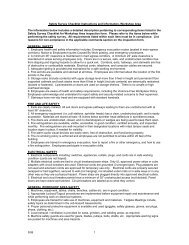
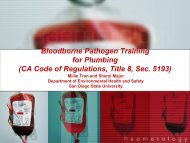
![Personal Protective Equipment [PDF]](https://img.yumpu.com/45263101/1/190x143/personal-protective-equipment-pdf.jpg?quality=85)
